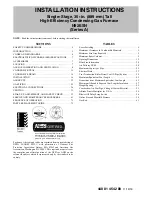
PG80MSU: Installation, Start-up, Operating and Service and Maintenance Instructions
Manufacturer reserves the right to change, at any time, specifications and designs without notice and without obligations.
5
CODES AND STANDARDS
Follow all national and local codes and standards in addition to these
instructions. The installation must comply with regulations of the
serving gas supplier, local building, heating, plumbing, and other codes.
In absence of local codes, the installation must comply with the national
codes listed below and all authorities having jurisdiction.
In the United States, follow all codes and standards for the following:
Safety
• USA: Current edition of National Fuel Gas Code (NFGC) NFPA
54/ANSI Z223.1 and the Installation Standards, Warm Air Heating
and Air Conditioning Systems ANSI/NFPA 90B
General Installation
• Current edition of the NFGC and the NFPA 90B. For copies, contact
the National Fire Protection Association Inc., Batterymarch Park,
Quincy, MA 02269; (www.NFPA.org) or for only the NFGC, contact
the American Gas Association, 400 N. Capitol Street, N.W.,
Washington, DC 20001 (www.AGA.org).
Combustion and Ventilation Air
• Current edition of NFGC NFPA54/ANSI Z223.1 Section 9.3, Air for
Combustion and Ventilation.
Duct Systems
• Air Conditioning Contractors Association (ACCA) Manual D, Sheet
Metal and Air Conditioning Contractors National Association
(SMACNA), or American Society of Heating, Refrigeration, and Air
Conditioning Engineers (ASHRAE) 2005 Fundamentals Handbook
Chapter 35 or 2004 HVAC Systems and Equipment Handbook
Chapters 9 and 16.
Acoustical Lining and Fibrous Glass Duct
• Current edition of SMACNA and NFPA 90B as tested by UL Standard
181 for Class I Rigid Air Ducts
Gas Piping and Gas Pipe Pressure Testing
• Current edition of NFGC NFPA54/ANSI Z223.1; chapters 5, 6, 7, and
8 and National Plumbing Codes.
Electrical Connections
• Current edition of National Electrical Code (NEC) NFPA 70.
Venting
• Current edition of NFGC NFPA 54 / ANSI Z223.1; Chapters 12 and
13.
ELECTROSTATIC DISCHARGE (ESD)
PRECAUTIONS PROCEDURE
1. Disconnect all power to the furnace. Multiple disconnects maybe
required. DO NOT TOUCH THE CONTROL OR ANY WIRE
CONNECTED TO THE CONTROL PRIOR TO DISCHARGING
YOUR BODY’S ELECTROSTATIC CHARGE TO GROUND.
2. Firmly touch the clean, unpainted, metal surface of the furnace
chassis which is close to the control. Firmly touch the clean,
unpainted, metal surface of the furnace chassis which is close to the
control. Tools held in a person’s hand during grounding will be
satisfactorily discharged.
3. After touching the chassis, you may proceed to service the control
or connecting wires as long as you do nothing to recharge your
body with static electricity (for example; DO NOT move or shuffle
your feet, do not touch ungrounded objects, etc.).
4. If you touch ungrounded objects (and recharge your body with
static electricity), firmly touch a clean, unpainted metal surface of
the furnace again before touching control or wires.
5. Use this procedure for installed and uninstalled (ungrounded)
furnaces.
6. Before removing a new control from its container, discharge your
body’s electrostatic charge to ground to protect the control from
damage. If the control is to be installed in a furnace, follow items 1
through 4 before bringing the control or yourself in contact with the
furnace. Put all used and new controls into containers before
touching ungrounded objects.
7. An ESD service kit (available from commercial sources) may also
be used to prevent ESD damage.
LOCATION
GENERAL
This multipoise furnace is shipped in packaged configuration. Some
assembly and modifications are required when used in any of the four
This furnace must:
• be installed so the electrical components are protected from water.
• not be installed directly on any combustible material other than wood
flooring for upflow applications. Downflow installations require use
of a factory-approved floor base or coil assembly when installed on
combustible materials or wood flooring (refer to SAFETY
CONSIDERATIONS).
• be located close to the chimney or vent and attached to an air
distribution system. Refer to Air Ducts section.
• be provided ample space for servicing and cleaning. Always comply
with minimum fire protection clearances shown on the furnace
clearance to combustible label.
The following types of furnace installations may require OUTDOOR
AIR for combustion due to chemical exposures:
• Commercial buildings
• Buildings with indoor pools
• Laundry rooms
• Hobby or craft rooms, and
CAUTION
!
FURNACE RELIABILITY HAZARD
Improper installation or service of furnace may cause premature
furnace component failure.
Electrostatic discharge can affect electronic components. Follow the
Electrostatic Discharge Precautions Procedure listed below during
furnace installation and servicing to protect the furnace electronic
control. Precautions will prevent electrostatic discharges from
personnel and hand tools which are held during the procedure. These
precautions will help to avoid exposing the control to electrostatic
discharge by putting the furnace, the control, and the person at the same
electrostatic potential.
WARNING
!
CARBON MONOXIDE POISONING HAZARD
Failure to follow this warning could result in personal injury or death,
and unit component damage.
Corrosive or contaminated air may cause failure of parts containing flue
gas, which could leak into the living space. Air for combustion must not
be contaminated by halogen compounds, which include fluoride,
chloride, bromide, and iodide. These elements can corrode heat
exchangers and shorten furnace life. Air contaminants are found in
aerosol sprays, detergents, bleaches, cleaning solvents, salts, air
fresheners, and other household products. Do not install furnace in a
corrosive or contaminated atmosphere. Make sure all combustion and
circulating air requirements are met, in addition to all local codes and
ordinances.






































